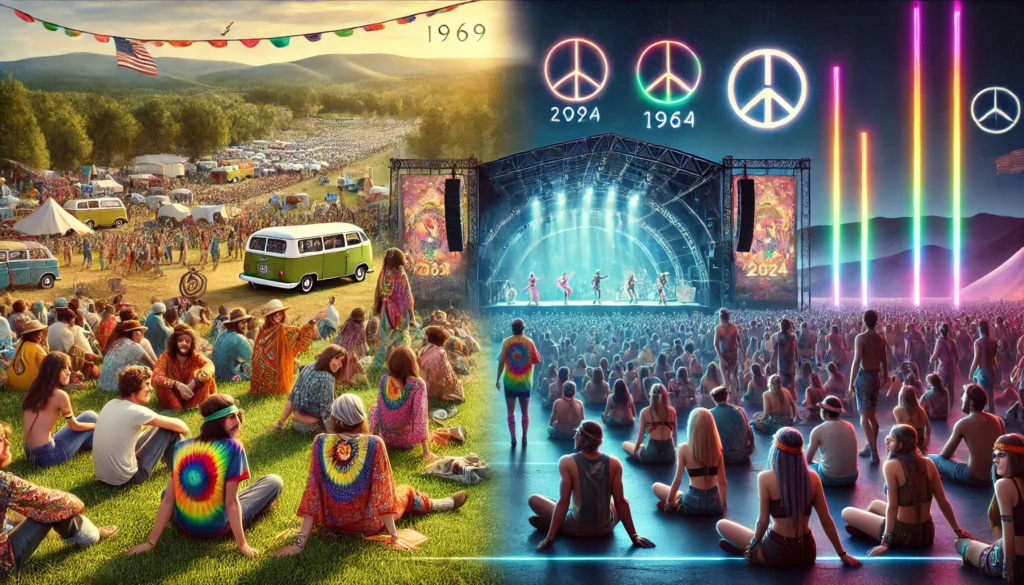The music festival scene has long been a cultural thermometer, reflecting the spirit of the times, shaping identities, and fostering collective experiences. When comparing Woodstock (1969), often regarded as the example of countercultural festivals, to Coachella (established in 1999), which epitomizes the modern, commercialized festival era, striking parallels and contrasts emerge. Both events are cultural milestones, yet they reflect distinct eras and priorities.
Woodstock: The Spirit of Counterculture
Woodstock, held in August 1969 on a farm in Bethel, New York, was not just a music festival but a political and cultural statement. Amidst the Vietnam War, civil rights movements, and the burgeoning hippie counterculture, Woodstock became a symbol of peace, love, and resistance to mainstream societal norms.
Core Themes:
•Unity in Diversity: Over 400,000 attendees gathered, united by a shared vision of peace and love.
•Countercultural Messaging: Performances by artists like Jimi Hendrix, Janis Joplin, and The Who carried overt political undertones, challenging authority and advocating for social change.
•Simplicity and Rawness: The festival lacked major corporate sponsorship, and its ad hoc logistics mirrored its raw and unfiltered ethos.
Woodstock’s emphasis on community over commerce established a legacy that continues to inspire festivals today.
Coachella: The Modern Festival Paradigm
In stark contrast, Coachella launched in 1999 in Indio, California, as a meticulously planned and commercially savvy event. It emerged during the digital revolution, targeting a generation less defined by political upheaval and more by technological connectivity and personal expression.
Core Themes:
•Cultural Curation: Coachella blends music, art installations, fashion, and celebrity culture to create a highly curated, Instagram-worthy experience.
•Commercialization: Unlike Woodstock, Coachella is heavily supported by corporate sponsorships, with major brands integrating their presence seamlessly into the festival experience.
•Inclusivity Through Technology: Coachella has embraced live streaming and social media, expanding its audience far beyond physical attendees.
While Woodstock championed a grassroots spirit, Coachella has perfected the art of the branded experience, emphasizing luxury, exclusivity, and global reach.
Comparing the Generations: What They Reflect
Woodstock and Coachella serve as mirrors of their respective eras, highlighting cultural priorities, societal shifts, and generational differences.
Counterculture vs. Mainstream Acceptance:
•Woodstock stood as a defiant outcry against societal norms, appealing to those seeking to challenge authority and reject materialism.
•Coachella, on the other hand, represents the absorption of festival culture into mainstream consumerism. Attendees view the event as a celebration of personal identity, often expressed through fashion and social media.
Music and Messaging:
•Woodstock’s performances were often politically charged, with artists using their platforms to protest wars and advocate for civil rights.
•Coachella, while diverse in musical offerings, rarely centers on overt political messaging, focusing instead on entertainment and self-expression.
Accessibility:
•Woodstock’s open gates and lack of structured ticketing epitomized its egalitarian ethos.
•Coachella, with its tiered ticket pricing and VIP experiences, caters to exclusivity and monetization.
Emerging Trends in Festival Culture
Today’s festival scene reflects a mix of Woodstock’s communal spirit and Coachella’s commercial savvy, with new trends reshaping the landscape.
Eco-Consciousness and Ethical Sustainability
Modern festivals are increasingly addressing environmental concerns, inspired by Woodstock’s alignment with natural simplicity. Coachella has introduced sustainability initiatives, including reusable water stations and solar-powered stages, reflecting the growing demand for eco-friendly events.
Inclusivity and Global Reach:
Woodstock may have symbolized unity, but modern festivals like Coachella are breaking barriers of race, gender, and geography. Artists from diverse genres and countries are headlining, reflecting a more interconnected global culture.
Technology Integration:
While Coachella pioneered live streaming, future trends involve immersive technologies like augmented and virtual reality. These innovations aim to replicate the festival experience for global audiences, much as Woodstock was broadcast on film and Coachella thrives on social media.
Wellness and Beyond-Music Experiences:
Festivals today are embracing wellness trends, offering yoga classes, mental health workshops, and organic food options. This evolution reflects a shift from purely hedonistic events to holistic lifestyle experiences.
Political and Social Awareness:
While Coachella has often avoided overt political messaging, festivals are beginning to incorporate panels, workshops, and artist activism, bridging the gap between Woodstock’s message-driven ethos and Coachella’s entertainment focus.
Why These Trends Are Emerging
The convergence of Woodstock’s ideals and Coachella’s commercial strategies is driven by several factors:
•Cultural Shifts: A new generation of festival-goers values authenticity and meaningful experiences, demanding that festivals address issues like climate change and social justice.
•Technological Advancements: Social media has transformed festivals into global phenomena, amplifying their influence and requiring them to cater to both physical and digital audiences.
•Economic Pressures: As festivals grow more expensive to produce, balancing authenticity with profitability is key. Coachella’s tiered pricing model offers a blueprint for financial sustainability.
Impression
Both Woodstock and Coachella represent milestones in the evolution of festival culture. While Woodstock captured the zeitgeist of the 1960s counterculture, Coachella reflects the interconnected, image-conscious world of the 21st century. Together, they highlight the transformative power of festivals to unite people, celebrate creativity, and reflect the priorities of their times.
As emerging trends shape the next generation of festivals, the enduring influence of Woodstock’s idealism and Coachella’s innovation ensures that these gatherings will continue to evolve, inspiring future generations to come together in the name of music, art, and shared humanity.
No comments yet.







